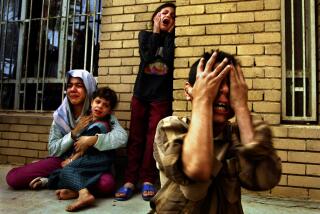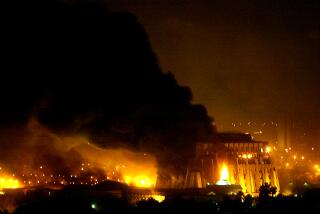Past haunts present at U.S. base in Iraq
- Share via
HABBANIYA, IRAQ — Lying at the edge of this vast military base, the quiet cemetery of 300 tombstones is a crumbling vestige of the British Empire. Once a Royal Air Force hub, the base now serves U.S. forces.
To historians, the base at Habbaniya, 50 miles west of Baghdad, represents one of many parallels between past and present.
Older Iraqis remember the British base as a symbol of foreign domination that stoked the country’s nationalist movement. Today, Habbaniya’s American occupants face similar hostility as they struggle to stabilize Iraq.
“Habbaniya was the focus of the most intense Iraqi resentment toward the Brits,” said Professor Rashid Khalidi, director of Columbia University’s Middle East Institute and a critic of the U.S.-led invasion. “If you thought [Iraqis] weren’t going to resist -- when they spent a good part of the 20th century trying to get the British out of there -- you’re out of your mind.”
The insurgency in the western province of Al Anbar, which includes Habbaniya as well as Fallouja, feeds off of Sunni Arab fear of being dominated by the Shiite majority in the post-Saddam Hussein era. But historians and veterans of Habbaniya’s British times detect deeper roots.
Neil Turnbull, who served in Habbaniya as a corporal and left on the second-to-last plane out of the base, remembers nearby Fallouja as particularly hostile.
Fallouja was “very anti-British the whole time. They would throw stones at buses and wagons that would pass,” said Turnbull, now 69.
Arriving in Iraq after World War I, the British quickly ran into resistance. In 1920, an Iraqi in Fallouja assassinated a senior British commander, Gerald Leachman, sparking a violent uprising against British rule. RAF warplanes crushed the uprising, but Fallouja remained the capital of anti-British resistance.
Today, the grandson of Leachman’s assassin is secretary-general of the Sunni Muslim Scholars Assn., the influential group linked to the insurgency.
“This is an old area with an old, ancient Sunni Arab population,” said Amatzia Baram, a professor of Middle East history at the University of Haifa in Israel. “If you hurt them and their interests
Britain had not come intending to make Iraq a full-blown colony in its vast empire. It wanted access to its oil and its port at Basra to protect its interests in India and Palestine. In 1932, Iraq became an independent monarchy, but then came World War II and the British military dug in, worried that Arabs were allying with Germany.
In 1941, pro-German Iraqi rebels besieged the Habbaniya base for several days. The British broke through and marched on Baghdad to crush the uprising, but not before encountering resistance in Fallouja.
“Habbaniya has such memories for Iraqis of a former generation. It was infamous in the same way that Abu Ghraib is today,” said Hala Fattah, resident director of the American Academic Research Institute in Iraq.
There’s another echo of the past in the bridge across the Euphrates River at Fallouja, from which a mob hung the charred bodies of two U.S. contractors in March 2004. The bridge was built by the British in the 1920s to move troops more quickly to Baghdad and became a point of frequent conflict.
Complicating matters for the British at the peak of their empire, and for the Americans today, are Iraqi society’s complex allegiances and tribal connections. Historians say many in Al Anbar have strong cultural, religious and family ties to Syria and Saudi Arabia.
Throughout the 19th and early 20th centuries, Sunni Wahhabis from present-day Saudi Arabia regularly marched through Al Anbar to attack Shiite cities in southern Iraq. In 1803, Wahhabis raided Karbala and destroyed one of the holiest Shiite shrines.
Nine months ago, insurgents thought to be from the same fundamentalist movement bombed the Shiite Golden Mosque in Samarra.
Since then, the U.S. military has redeployed troops to tackle a wave of sectarian violence, just as the British did in the 1920s, using warplanes and a proxy army to stop Wahhabi raids.
Christopher Morris was a 10-year-old living on the Habbaniya base when his father was stationed here in 1955.
At one point it was the RAF’s largest overseas base, with dozens of planes and up to 3,000 Britons, he said. It had an Olympic-size swimming pool, soccer fields, tennis courts, a theater, a horse-racing track, three churches and gardens of roses and hibiscus.
Christians and Kurds serving as Britain’s proxy soldiers lived in a separate part of the base -- an arrangement similar to the present one in which Iraqi and American soldiers live separated by barbed wire.
The British era ended in 1958, when rebels executed Iraq’s royal family and closed in on Habbaniya’s base. The next year, the British military withdrew entirely, leaving the bases to the new Iraqi government.
“On the day of the revolution, they just took over the camp, took over the armory, the transport,” said Turnbull, the ex-corporal, who remembers being pushed into one corner of the camp as rebels took over most of Habbaniya. “They weren’t shooting us, but they were hostile.”
The abrupt takeover was a shock.
“We thought we were going to be there permanently,” Turnbull said. “Everything seemed fine and normal, and then the revolution came out of the blue.”
Saddam Hussein came to power in 1979, and in the spring of 2003, Habbaniya was taken by coalition forces. It is now a sprawling logistics hub supplying U.S. Marines.
British forces are also in Iraq, though not at Habbaniya. This time they serve in the south.
Today, the swimming pool holds murky rainwater. Only one of the churches still stands, stripped of its crosses and converted into a mosque. Propaganda murals from the Hussein era adorn the theater.
The headstones on most of the British graves lie in the dead grass. But at the request of British relatives of the dead, U.S. soldiers have cleaned up the cemetery and laid wreaths.
More to Read
Sign up for Essential California
The most important California stories and recommendations in your inbox every morning.
You may occasionally receive promotional content from the Los Angeles Times.













